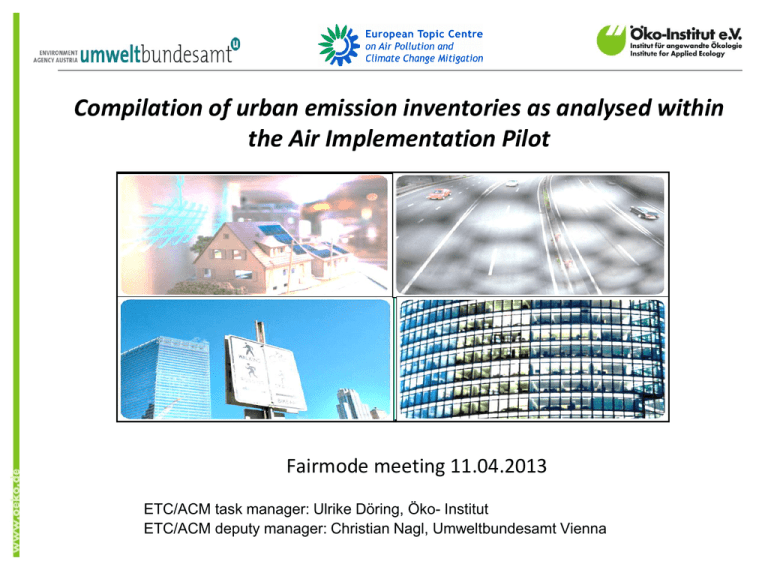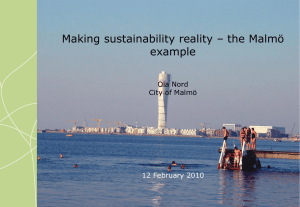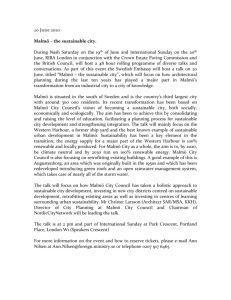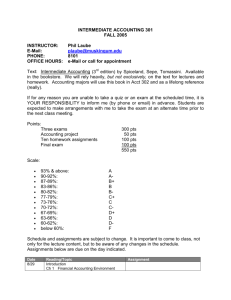WG1 - Air Implementation Pilot Emissions
advertisement

Compilation of urban emission inventories as analysed within the Air Implementation Pilot Fairmode meeting 11.04.2013 ETC/ACM task manager: Ulrike Döring, Öko- Institut ETC/ACM deputy manager: Christian Nagl, Umweltbundesamt Vienna Background Problem: Air quality in cities still remains a problem in Europe. => NOx & particle emissions => greenhouse gas emissions Main sources here: transport, construction machinery, residential sector. For improving the situation a review of the existing EU strategy on air pollution and climate change mitigation policy started in 2012 - integrated in an Air Implementation Pilot project. 2 Background Air Implementation Pilot => Joint EEA – DG ENV project => Focused on cities in the EU. Set-up for modelling activities under FAIRMODE task in ETC/ACM’s Implementation Plans of 2012 and 2013! AIP OBJECTIVES Share experiences among pilot cities; Develop proposals for improved implementation; Share experiences with other cities; Not intended to solve AQ problems, but improve information base for future action. 3 Objectives for the two city pilot projects 1a) Analysis of existing initiatives and projects & local initiatives in the CC/AP mitigation field & 1b) questionnaires of city inventories 2. Overview & understanding of the results of the studies 3. Where are the gaps and what can we learn? 4 Structured in four main groups General issues • project group • contact • finances • duration of project Emission inventories at local level • pollutants • methodology (EF, AD) • data handling & availability • updates Information on policies & measures • availability of information • good practices Other • project conclusions • findings • sharing of network 5 Why emission inventories (EI)? • Identification of the local sources of pollution; • Knowledge on the contribution each source; • Identification & implementation of measures to improve local air quality; • Monitoring the calculated change in emissions with time. 6 Emission trends & reports Source: EEA, EU National Inventory Report, 2012 Source: EEA, European Union emission inventory report 1990–2010 under the UNECE Convention on Long-range Transboundary Air Pollution (LRTAP) , 2012 7 Main questions: Comparability of different approaches Availability of data Guidance, QA/QC Use of co-benefits (pollutants) Use of EI 8 Choise of city projects (in total 11 projects): • Covenant of Mayors (CoM) • Common Information to European Air, CiteAir • EU CO2 80/50 Project Selection of cities: Antwerp, Berlin, Madrid, Malmö, Paris, Plovdiv, Vienna, Vilnius, Milan, Ploieşti, Prague. Dublin started preparing an EI. 9 Main results - use of EI Identification of sources Modelling Identifying measures Covenant of Mayors (CoM) CiteAir EU CO2 80/50 Project City Antwerp, Berlin, Madrid, Milan, Paris, Ploieşti, Prague, Vienna, Vilnius Malmö Plovdiv 10 NEC AQD AQD, GP AQD Vilnius Vienna Prague Milan Plovdiv Malmö Ploieşti Madrid, Paris Berlin EU CO2 80/50 Project Antwerp NEC, AQD (NO2) NEC, AQD NEC, AQD CiteAir II Covenant of Mayors (CoM) Obligation Main results - pollutants AQD DD4 DD4 UNFCCC CO2 NEC: National Emission Ceiling Directive 2001/81/EC, AQD: Air Quality Directive 2008/50/EC DD4: 4th Daughter Directive 2004/107/EC, GP: revised Gothenburg Protocol under the CLRTAP UNFCCC: United Nations Framework Convention on Climate Change 11 Main results – co-benefits CC/AQ Impact of AQ/CC measures in CC/AQ City/ Projects Covenant of Mayors (CoM) CiteAir II EU CO2 80/50 Project AQ in climate change Not applicable Not applicable Not applicable Climate change in AQ Not applicable Partly Not applicable Antwerp Berlin, Paris, Ploieşti, Vienna Madrid Malmö Milan Plovdiv, Prague, Vilnius partly No information provided No information provided Not applicable partly Partly Partly Not applicable 12 Main results - internal guidance City Covenant of Mayors (CoM) CiteAir II EU CO2 80/50 Project Antwerpen, Berlin, Madrid, Paris, Plovdiv, Vienna & Vilnius Malmö Milan Ploieşti Prague Internal Guidance SEAP guidelines Guidebook on integrated emission inventories (also: IMACE database and IMACE guidebook) Metropolitan Mitigation Measures Sourcebook No Gustafsson (2007) Methodology and information available at: http://www.inemar.eu/xwiki/bin/view/InemarDatiWeb/Metodologia+utilizzata Report - guidance on developing local and national emission inventories in conformity with EMEP/EEA – 2009 URM Internal Guidelines for EI 13 Main results – data availability City Emission data Covenant of Mayors (CoM) CiteAir EU CO2 80/50 Project Eurocities network internet presentation of the results network platform Antwerp Annual report on the VMM website Berlin Web based GIS tool Madrid & Milan Web based report Malmö Annual report and a web tool Paris AIRPARIF website Ploieşti Environmental situation report Plovdiv Partly in air quality progamme Prague Web based report, data Vienna & Vilnius No 14 Main results – Reference for EF City Covenant of Mayors (CoM) CiteAir EU CO2 80/50 Project GHG: IPCC Guidebook on integrated emission inventories (also: IMACE database and IMACE guidebook) GHG: IPCC Antwerp CR-CORINAIR References traffic: IMMIS-em: (modelled), HBEFA 3.1 (www.hbefa.net) Berlin tyre abrasion and resuspension: Düring & Lohmeyer (2004) evaporative losses: HBEFA3.1 heating: Umeg (2000) construction machinery: Ifeu (2004) Madrid GHG: IPCC; AP: EMEP/CORINAIR; traffic: COPERT 4 Malmö no information provided Milan, Ploiesti GHG: IPCC; AP: EMEP/CORINAIR Paris national guidance CITEP (http://www.citepa.org/images/III1_Rapports_Inventaires/OMINEA_9eme%20edition%202012sec.zip) and EMEP/CORINAIR Plovdiv CR-CORINAIR, HBEFA, CS-country specific, PS-plant specific Prague EMEP/CORINAIR, national guidance for traffic emissions Vienna EMEP/CORINAIR, HBEFA 15 Main results - comparability City Comparability Covenant of Mayors (CoM) applied guidelines yes, inventories no CiteAir No EU CO2 80/50 Project No Antwerp Yes (downscaled from the regional inventory) Berlin Not comparable to other cities Madrid Theoretically yes: The Municipal Inventory is contrasted with the national and regional inventories Malmö Fully comparable with the regional (Scania) EI and the Göteborg EI, partly comparable to the Stockholm EI (bottom-up), but not directly comparable to the national EI (mostly top-down) Milan Yes (regional inventory containing data on each city in the region; the methodology is shared with 6 further regions and 2 provinces) Paris Yes, other regional inventories are built with the same methodologies Ploieşti, Prague, Vilnius No Plovdiv & Vienna Yes 16 Conclusions • Good quality input data is essential (e.g. on traffic statistics, household combustion practices, construction emissions ); • There are significant differences in comparability, completeness and consistency between the inventories; • Currently the EI can be used for qualitative assessments on a European level. Use for modelling or source apportionment requires substantial effort for harmonization. 17 Conclusions • Necessity for improved guidance for estimating fugitive and diffuse emissions (e.g. resuspension from traffic, construction work etc.), emissions of residential heating, future traffic emissions and for QA/QC in general; • Several cities and city projects consider and integrate synergies between management of air quality and greenhouse gases when planning action plans or measures. Brochure: compilation of guidance material 18 Contacts Christian Nagl +43-1-31304-5866, christian.nagl@umweltbundesamt.at Ulrike Döring +49-30-405085-303, u.doering@oeko.de Thank you! 19 11 city projects were analysed! 1. Covenant of Mayors (CoM) 2. Megapoli 3. CityZen, mega CITY - Zoom for the Environment 4. Soot free cities campaign 5. European Green City Index 6. Common Information to European Air, CiteAir 7. METREX - The Network of European Metropolitan Regions and Areas 8. InterMETREXplus Project 9. EUCO2 80/50 Project 10. Climate Cities Benchmark (CCB) 11. Fairmode 20






